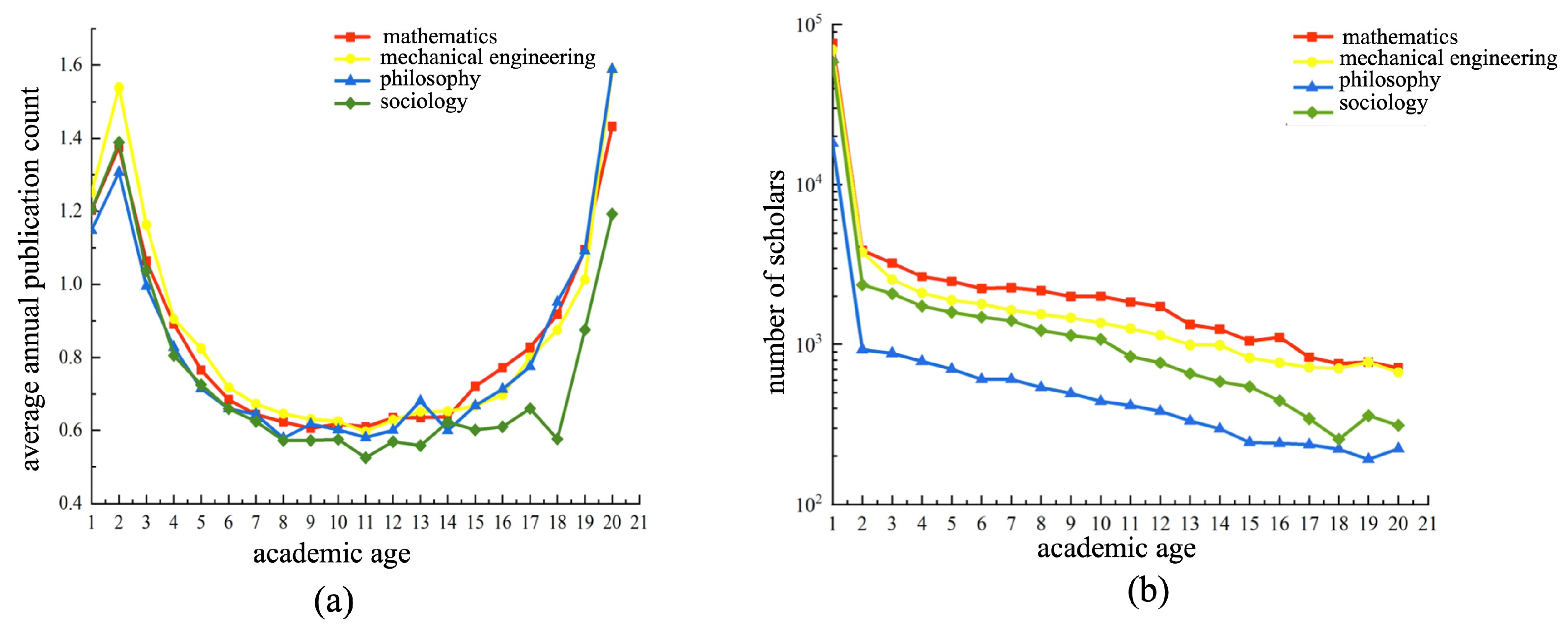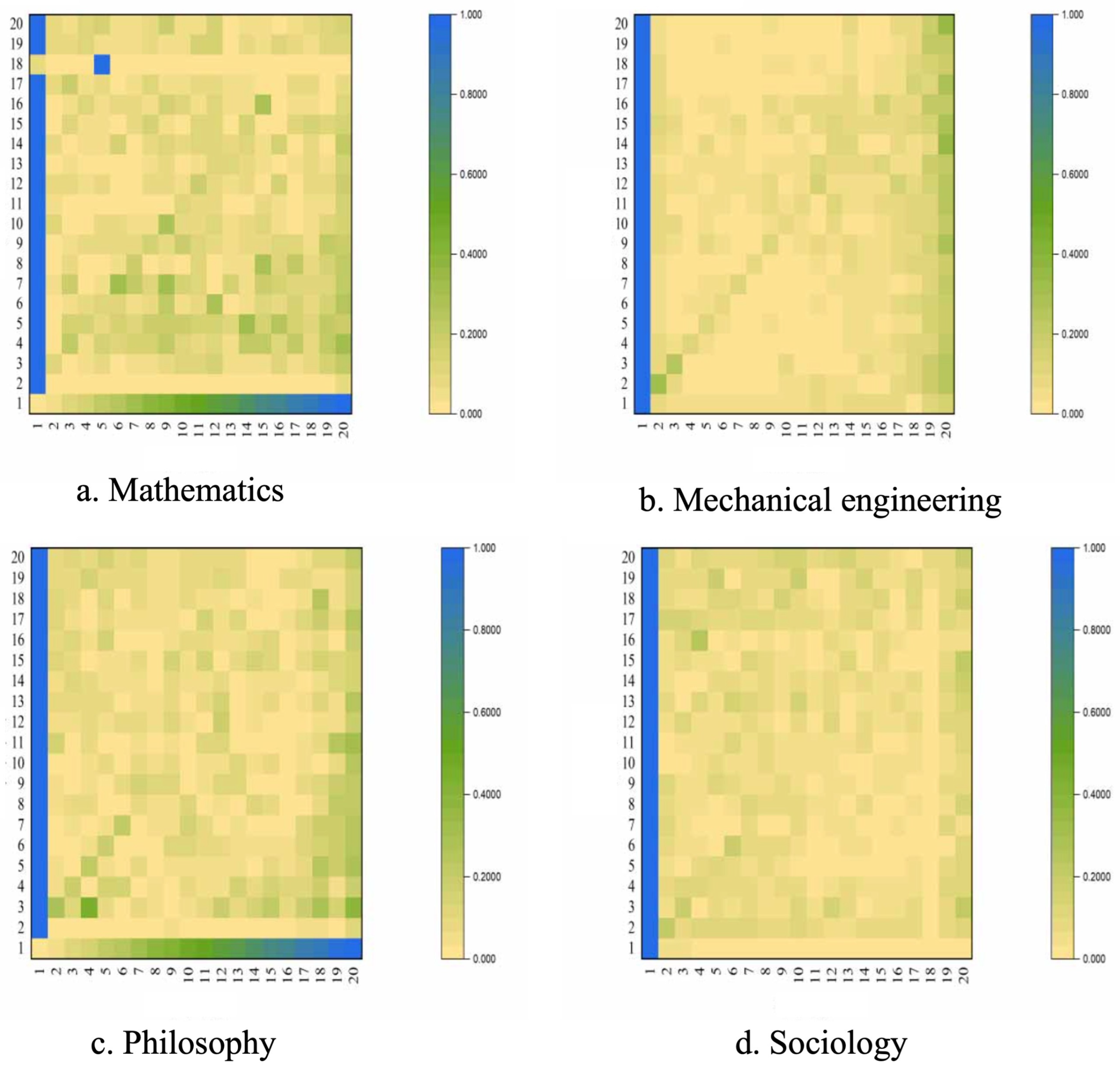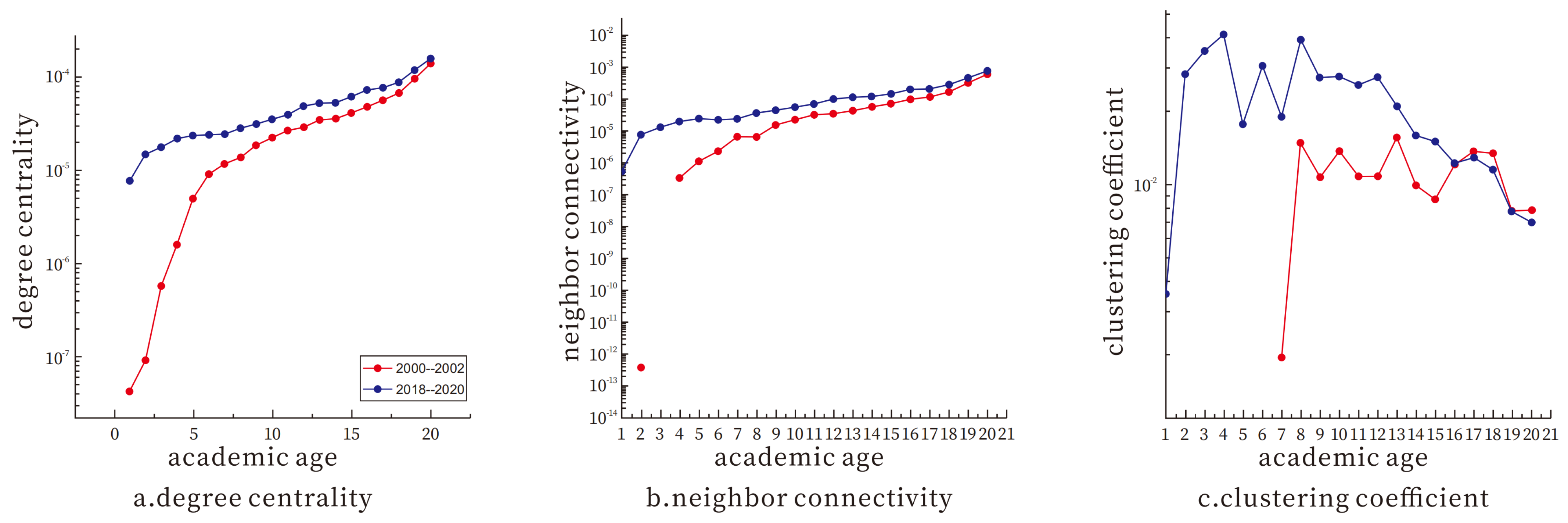Exploring Scientific Collaboration Patterns from the Perspective of Disciplinary Difference: Evidence from Scientific Literature Data
Abstract
1. Introduction
- What are the differences in collaboration patterns among these four disciplines: mathematics, mechanical engineering, philosophy, and sociology?
- How do these network characteristics dynamically change with scholars’ academic ages?
- What reasons lead to the aforementioned differences?
2. Literature Review
2.1. Scientific Collaboration Patterns
2.2. Influencing Factors of Scientific Collaboration
- Economic factors: Economic factors are the foundation for conducting academic research and are also a significant consideration for researchers when engaging in collaboration. During the process of academic research, the costs, such as the purchase of large experimental equipment, must be considered [29]. Research shows that scientific collaboration among scholars can effectively reduce research costs, and sharing experimental equipment is an important driving force in the collaboration [30]. Birnholtz found that scientific collaborations, such as establishing joint laboratories and setting up joint projects, can provide collaborators with facilities and platform support [31]. Lee conducted a survey of members of the National Academy of Sciences and Engineering in the United States and found that the economic benefits and other related resources obtained are important factors in promoting the scientific collaboration [32].
- Knowledge production: An important reason for engaging in scientific collaboration is to promote knowledge production. In recent decades, knowledge has become increasingly complex, necessitating collaboration among scholars from multiple fields to produce new knowledge [33]. Authors publishing in high-quality journals tend to have stronger common research interests with their co-authors. Core authors are experts in their fields, and they prefer to collaborate with experts who have similar research interests to delve into specialized research topics rather than broadly studying multiple fields superficially [34]. Additionally, with the refinement of knowledge and disciplinary classification, interdisciplinary integration has become a new research trend. Wu et al. believe that to address the needs of interdisciplinary research, collaboration among scholars from different disciplines can help them inspire each other, leading to the generation of new ideas [35]. A theory of collaborative knowledge production has been proposed, indicating that the knowledge production efficiency is highest when collaborators’ shared and differing knowledge is at a balanced level [36]. Research also indicates that the achievements of scientific research remain a determining factor in scientific collaboration [37].
- Social reputation: Scientific collaboration is an important means of maintaining social relationships and is also a necessary way to enhance social reputation. Scholars can maintain existing social relationships and create new ones through scientific collaboration, thereby accumulating human capital [38]. Research suggests that scholars tend to collaborate with peers from external organizations, which can publish academic articles in high-quality journals, and gain a good academic reputation [39]. Brands et al. found that scientists’ engagement in scientific collaborations is driven by utilitarian motivation, aimed at enhancing their reputation or gaining professional advantages through collaboration [40]. When researchers have achieved a certain social status, their motivation to publish papers increasingly stems from the pursuit of social reputation [10].
3. Data and Research Methodology
3.1. Dataset
3.2. Research Methodology
- Beginner scholars: Academic Age ≤ 5 years.
- Junior scholars: 5 < Academic Age ≤ 15 years.
- Senior scholars: Academic Age > 15 years.
- Degree Centrality (DC). This metric quantifies the number of direct collaborators a scholar has. We represent the collaboration network as a graph , where V is the set of scholars (nodes) and E is the set of collaboration ties (edges). The degree centrality of a scholar i, denoted as , is simply its degree, .where counts the number of scholars with whom scholar i has directly collaborated.
- Neighbor Connectivity (NC). This metric measures the average centrality (degree) of a scholar’s collaborators, reflecting their tendency to collaborate with high- or low-degree peers. The neighbor connectivity for scholar i, , is defined as the average degree of the nodes in its neighborhood.where is the set of neighbors of node i, is the degree of node i and is the degree of a neighboring node j.
- Clustering Coefficient (CC). We use the local clustering coefficient to measure how tightly clustered a scholar’s collaborators are (i.e., the probability that any two of their collaborators also collaborate with each other). For a scholar i with degree , its local clustering coefficient, , is the ratio of the number of actual edges between its neighbors () to the maximum possible number of edges between them.where is the number of edges connecting the neighbors of scholar i to each other. A higher indicates a more cohesive or tightly knit collaboration circle around scholar i.
4. Results
4.1. Distribution of Scholars’ Academic Ages
4.2. Scholars’ Network Characteristics
4.3. Scientific Collaboration Patterns
- Beginner scholars in mathematics and philosophy collaborate less with peers, while those in mechanical engineering collaborate more. This indicates the varying preferences for choosing collaboration partners across disciplines.
- Junior scholars’ collaboration preferences differ by discipline. In mathematics, sociology, and mechanical engineering, junior scholars collaborate more with peers, while philosophy scholars prefer collaborating with beginner and senior scholars.
- Generally, senior scholars collaborate the most with peers. However, in philosophy, senior–senior collaborations are relatively low, potentially due to different research interests and directions among senior scholars.
4.4. Academic Age Distribution of Collaborator Pairs
4.5. Comparison of Network Characteristics Across Different Time Periods
5. Discussion
5.1. Attribute Differences Across Disciplines
5.1.1. Different Knowledge Attributes
5.1.2. Different Organizational Attributes
5.2. Development Differences of Disciplines
5.2.1. Different Social Development Needs
5.2.2. Different Material Conditions
5.2.3. Different Individual Characteristics of Scholars
6. Conclusions
Author Contributions
Funding
Institutional Review Board Statement
Informed Consent Statement
Data Availability Statement
Conflicts of Interest
References
- Sun, Y.; Zhang, C.; Kok, R.A. The role of research outcome quality in the relationship between university research collaboration and technology transfer: Empirical results from China. Scientometrics 2020, 122, 1003–1026. [Google Scholar] [CrossRef]
- Kwiek, M.; Roszka, W. Gender-based homophily in research: A large-scale study of man-woman collaboration. J. Inf. 2021, 15, 101171. [Google Scholar] [CrossRef]
- Waham, J.J.; Asfahani, A.; Ulfa, R.A. International collaboration in higher education: Challenges and opportunities in a globalized world. EDUJAVARE Int. J. Educ. Res. 2023, 1, 49–60. [Google Scholar] [CrossRef]
- Wang, F.; Dong, J.; Lu, W.; Xu, S. Collaboration prediction based on multilayer all-author tripartite citation networks: A case study of gene editing. J. Inf. 2023, 17, 101374. [Google Scholar] [CrossRef]
- Xi, X.; Wei, J.; Guo, Y.; Duan, W. Academic collaborations: A recommender framework spanning research interests and network topology. Scientometrics 2022, 127, 6787–6808. [Google Scholar] [CrossRef]
- Ma, N.; Guan, J. An exploratory study on collaboration profiles of Chinese publications in Molecular Biology. Scientometrics 2005, 65, 343–355. [Google Scholar] [CrossRef]
- Olechnicka, A.; Ploszaj, A.; Celińska-Janowicz, D. The Geography of Scientific Collaboration; Taylor & Francis: Abingdon, UK, 2019. [Google Scholar]
- Fan, L.; Guo, L.; Wang, X.; Xu, L.; Liu, F. Does the author’s collaboration mode lead to papers’ different citation impacts? An empirical analysis based on propensity score matching. J. Inf. 2022, 16, 101350. [Google Scholar] [CrossRef]
- Karlsdottir, V.; Torfason, M.T.; Edvardsson, I.R.; Heijstra, T.M. Barriers to academic collaboration with industry and community: Individual and organisational factors. Ind. High. Educ. 2023, 37, 792–809. [Google Scholar] [CrossRef]
- Moirano, R.; Sánchez, M.A.; Štěpánek, L. Creative interdisciplinary collaboration: A systematic literature review. Think. Ski. Creat. 2020, 35, 100626. [Google Scholar] [CrossRef]
- London, R.A.; Glass, R.D.; Chang, E.; Sabati, S.; Nojan, S. “We Are About Life Changing Research”: Community Partner Perspectives on Community-Engaged Research Collaborations. J. High. Educ. Outreach Engagem. 2022, 26, 19–36. [Google Scholar]
- Kwiek, M. What large-scale publication and citation data tell us about international research collaboration in Europe: Changing national patterns in global contexts. Stud. High. Educ. 2021, 46, 2629–2649. [Google Scholar] [CrossRef]
- Abramo, G.; D’Angelo, C.A.; Murgia, G. Variation in research collaboration patterns across academic ranks. Scientometrics 2014, 98, 2275–2294. [Google Scholar] [CrossRef]
- Wang, W.; Yu, S.; Bekele, T.M.; Kong, X.; Xia, F. Scientific collaboration patterns vary with scholars’ academic ages. Scientometrics 2017, 112, 329–343. [Google Scholar] [CrossRef]
- Wilsdon, J. Knowledge, Networks and Nations: Global Scientific Collaboration in the 21st Century; University of Sussex: Falmer, UK, 2011. [Google Scholar]
- Adams, J. The rise of research networks. Nature 2012, 490, 335–336. [Google Scholar] [CrossRef] [PubMed]
- Liu, Y.; Ma, J.; Song, H.; Qian, Z.; Lin, X. Chinese universities’ cross-border research collaboration in the social sciences and its impact. Sustainability 2021, 13, 10378. [Google Scholar] [CrossRef]
- Chen, P.Y. Academic social networks and collaboration patterns. Libr. Hi Tech 2020, 38, 293–307. [Google Scholar] [CrossRef]
- Marijan, D.; Sen, S. Industry–academia research collaboration and knowledge co-creation: Patterns and anti-patterns. ACM Trans. Softw. Eng. Methodol. 2022, 31, 1–52. [Google Scholar] [CrossRef]
- Perkmann, M.; Salandra, R.; Tartari, V.; McKelvey, M.; Hughes, A. Academic engagement: A review of the literature 2011–2019. Res. Policy 2021, 50, 104114. [Google Scholar] [CrossRef]
- Boekhout, H.; van der Weijden, I.; Waltman, L. Gender differences in scientific careers: A large-scale bibliometric analysis. arXiv 2021. [Google Scholar] [CrossRef]
- Huang, J.; Gates, A.J.; Sinatra, R.; Barabási, A.L. Historical comparison of gender inequality in scientific careers across countries and disciplines. Proc. Natl. Acad. Sci. USA 2020, 117, 4609–4616. [Google Scholar] [CrossRef] [PubMed]
- Ross, M.B.; Glennon, B.M.; Murciano-Goroff, R.; Berkes, E.G.; Weinberg, B.A.; Lane, J.I. Women are credited less in science than men. Nature 2022, 608, 135–145. [Google Scholar] [CrossRef] [PubMed]
- Abramo, G.; D’Angelo, C.A.; Murgia, G. Gender differences in research collaboration. J. Inf. 2013, 7, 811–822. [Google Scholar] [CrossRef]
- Cruz-Castro, L.; Ginther, D.K.; Sanz-Menéndez, L. Gender and underrepresented minorities differences in research funding. In Handbook of Public Funding of Research; National Bureau of Economic Research: Cambridge, MA, USA, 2023; pp. 279–300. [Google Scholar]
- Abramo, G.; Aksnes, D.W.; D’Angelo, C.A. Gender differences in research performance within and between countries: Italy vs. Norway. J. Inf. 2021, 15, 101144. [Google Scholar] [CrossRef]
- Meng, Y. Collaboration patterns and patenting: Exploring gender distinctions. Res. Policy 2016, 45, 56–67. [Google Scholar] [CrossRef]
- Newman, M.E. Scientific collaboration networks. I. Network construction and fundamental results. Phys. Rev. 2001, 64, 016131. [Google Scholar] [CrossRef]
- Yadav, A.; McHale, J.; O’Neill, S. How does co-authoring with a star affect scientists’ productivity? Evidence from small open economies. Res. Policy 2023, 52, 104660. [Google Scholar] [CrossRef]
- He, C.; Wu, J.; Zhang, Q. Characterizing research leadership on geographically weighted collaboration network. Scientometrics 2021, 126, 4005–4037. [Google Scholar] [CrossRef]
- Birnholtz, J.; Guha, S.; Yuan, Y.C.; Gay, G.; Heller, C. Cross-campus collaboration: A scientometric and network case study of publication activity across two campuses of a single institution. J. Am. Soc. Inf. Sci. Technol. 2013, 64, 162–172. [Google Scholar] [CrossRef]
- Lee, Y.S. The sustainability of university-industry research collaboration: An empirical assessment. J. Technol. Transf. 2000, 25, 111–133. [Google Scholar] [CrossRef]
- Vlase, I.; Lähdesmäki, T. A bibliometric analysis of cultural heritage research in the humanities: The Web of Science as a tool of knowledge management. Humanit. Soc. Sci. Commun. 2023, 10, 1–14. [Google Scholar] [CrossRef] [PubMed]
- Zhu, N.; Liu, C.; Yang, Z. Team size, research variety, and research performance: Do coauthors’ coauthors matter? J. Inf. 2021, 15, 101205. [Google Scholar] [CrossRef]
- Wu, L.; Yi, F.; Bu, Y.; Lu, W.; Huang, Y. Toward scientific collaboration: A cost-benefit perspective. Res. Policy 2024, 53, 104943. [Google Scholar] [CrossRef]
- Berliant, M.; Fujita, M. Knowledge creation as a square dance on the Hilbert cube. Int. Econ. Rev. 2008, 49, 1251–1295. [Google Scholar] [CrossRef]
- Freeth, R.; Caniglia, G. Learning to collaborate while collaborating: Advancing interdisciplinary sustainability research. Sustain. Sci. 2020, 15, 247–261. [Google Scholar] [CrossRef]
- Casad, B.J.; Franks, J.E.; Garasky, C.E.; Kittleman, M.M.; Roesler, A.C.; Hall, D.Y.; Petzel, Z.W. Gender inequality in academia: Problems and solutions for women faculty in STEM. J. Neurosci. Res. 2021, 99, 13–23. [Google Scholar] [CrossRef] [PubMed]
- O’Kane, C.; Mangematin, V.; Zhang, J.A.; Haar, J. How research agendas are framed: Insights for leadership, learning and spillover in science teams. Res. Policy 2024, 53, 105029. [Google Scholar] [CrossRef]
- Brands, R.; Ertug, G.; Fonti, F.; Tasselli, S. Theorizing gender in social network research: What we do and what we can do differently. Acad. Manag. Ann. 2022, 16, 588–620. [Google Scholar] [CrossRef]
- Petersen, A.M. Quantifying the impact of weak, strong, and super ties in scientific careers. Proc. Natl. Acad. Sci. USA 2015, 112, E4671–E4680. [Google Scholar] [CrossRef]
- Bianchi, P.A.; Causholli, M.; Minutti-Meza, M.; Sulcaj, V. Social networks analysis in accounting and finance. Contemp. Account. Res. 2023, 40, 577–623. [Google Scholar] [CrossRef]
- Borgatti, S.P.; Agneessens, F.; Johnson, J.C.; Everett, M.G. Analyzing Social Networks; SAGE Publications Inc.: Thousand Oaks, CA, USA, 2024. [Google Scholar]
- Becher, T.; Trowler, P. Academic Tribes and Territories; McGraw-Hill Education: Columbus, OH, USA, 2001. [Google Scholar]









Disclaimer/Publisher’s Note: The statements, opinions and data contained in all publications are solely those of the individual author(s) and contributor(s) and not of MDPI and/or the editor(s). MDPI and/or the editor(s) disclaim responsibility for any injury to people or property resulting from any ideas, methods, instructions or products referred to in the content. |
© 2025 by the authors. Licensee MDPI, Basel, Switzerland. This article is an open access article distributed under the terms and conditions of the Creative Commons Attribution (CC BY) license (https://creativecommons.org/licenses/by/4.0/).
Share and Cite
Zhang, J.; Liu, S.; Wang, Y. Exploring Scientific Collaboration Patterns from the Perspective of Disciplinary Difference: Evidence from Scientific Literature Data. Big Data Cogn. Comput. 2025, 9, 201. https://doi.org/10.3390/bdcc9080201
Zhang J, Liu S, Wang Y. Exploring Scientific Collaboration Patterns from the Perspective of Disciplinary Difference: Evidence from Scientific Literature Data. Big Data and Cognitive Computing. 2025; 9(8):201. https://doi.org/10.3390/bdcc9080201
Chicago/Turabian StyleZhang, Jun, Shengbo Liu, and Yifei Wang. 2025. "Exploring Scientific Collaboration Patterns from the Perspective of Disciplinary Difference: Evidence from Scientific Literature Data" Big Data and Cognitive Computing 9, no. 8: 201. https://doi.org/10.3390/bdcc9080201
APA StyleZhang, J., Liu, S., & Wang, Y. (2025). Exploring Scientific Collaboration Patterns from the Perspective of Disciplinary Difference: Evidence from Scientific Literature Data. Big Data and Cognitive Computing, 9(8), 201. https://doi.org/10.3390/bdcc9080201




